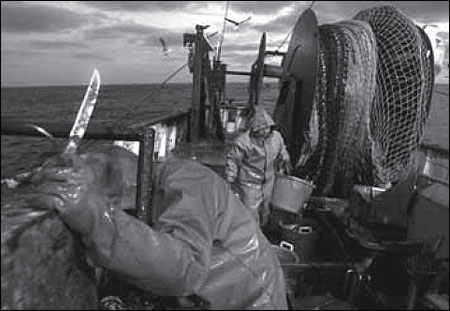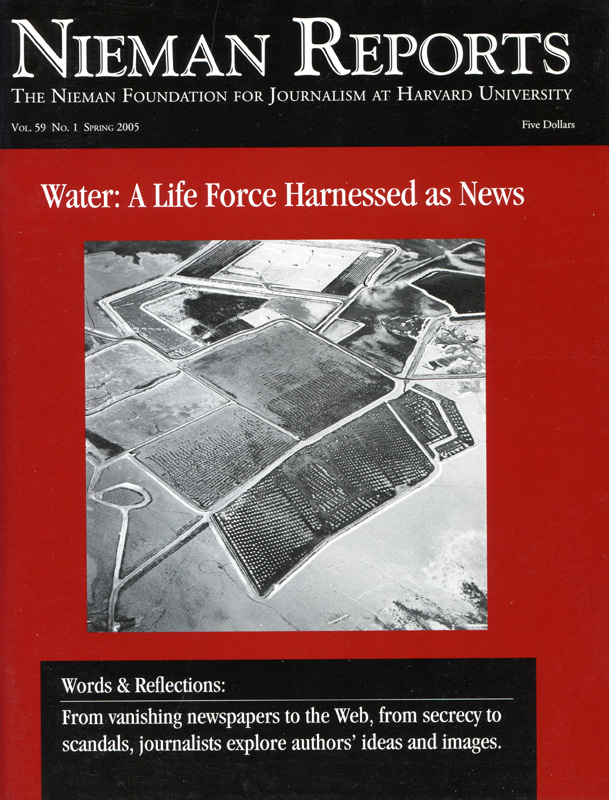
Two and a half years ago I started to write stories about oceans, but I’ve never explored the beat the way a good journalist does: By being there. Except for a dozen or so ferry rides and fishing trips, virtually all of the stories I’ve written about the ocean have been discovered, reported and written from land. It’s hard to get onto the water and, even when I have, most of the real action is going on under the surface. But in many respects, this difficulty has been a benefit in forcing me to look at ocean stories through the lens of economics, history, relationships and culture.
Beginning in the fall of 2000, when I began working at The Boston Globe as its environment reporter, I spent much of my reporting time in the forests, streams and mountains of New England and also writing about lead poisoning and other urban environmental health issues. But after 9/11, like many journalists, the topics of my coverage shifted to anthrax scares and aspects of terrorism. I didn’t return to this beat until mid-2002 and, by then, the Atlantic Ocean off New England’s coastline was re-emerging as a critical story for the Globe to cover.
Commercial fishing faced its biggest challenge ever due to a lawsuit by environmental groups, while salmon farms were blanketing Down East Maine and breathing new economic life into the poorest places in the state. Waters off New England were being bombarded with new energy proposals, ranging from the nation’s first offshore wind farm (which would be located in Nantucket Sound) to several proposed sites for liquefied natural gas terminals. My editors asked me to dive into these complex issues. I went from writing perhaps one or two ocean stories every six months when I first started this beat to writing dozens of them. Forests and virtually everything else were pushed to the backburner, and ocean-related stories consumed some 70 percent of my time.
Undiscovered Depths
Oceanographers like to say that there is more known about the moon than the bottom of the sea. Yet virtually everyone agrees the world’s oceans, once thought inexhaustible, are in imminent danger of being emptied of fish. The United Nations recently named overfishing as one of the 10 most important, but least written about, subjects. Only recently have environmental groups begun to pay attention to the oceans and, as they have, their focus is shifting public perception about how the oceans should be managed, what should be taken from them, and what countries’ fishing boats should be allowed on which swaths of the sea.
Knowing little about the ocean or these issues, I blanketed universities and aquariums to ask about ongoing and interesting research. It was as if my inquiry had turned on a spigot: Research dollars were increasing for ocean studies and, as a consequence, related technologies and story ideas were everywhere. Here’s a sampling of what I found:
- The United States was quietly trying to more accurately map the continental shelf off the nation’s coast in hope of extending its seabed rights farther out from shore, an extension that could be worth billions of dollars.
- Sophisticated technology helped to locate one of New England’s most famous shipwrecks 450 feet below the ocean surface.
- Recreational boat use was rising, and arguments about new marinas were escalating.
- Remote vehicles, many developed and based in New England, were catching up to scientists’ ambitions to examine deep, cold-water corals and other treasures.
Within a few months, however, it was clear that New England fishing was the biggest story. For 200 years the region’s economic engine revolved around the plentiful cod, so much so that a carved wooden cod still hangs in the Massachusetts Statehouse. But fishermen had taken too many of these fish, and stocks weren’t being replenished fast enough despite a tightening—and confusing—array of regulation. Fishermen, who not long ago proudly came into port with hundreds of thousands of pounds of flounder and haddock, were now forced to hunt slime eels, an animal that snakes into dying fish to eat them from the inside out.
Clearly an investigation was needed to help our readers understand why New England couldn’t seem to make commercial fishing work well in the 21st century or discuss if this way of life was truly on its deathbed. The Globe had tackled variations of this topic before, so it was difficult to see how the reporting we’d do this time would yield different stories. We’d done feature articles about the robust life of a fisherman on the brink and written about the industry’s history, even about the fish. Complicating the matter was that the more I learned about fishing, the less clarity there seemed. No clear villains were emerging, nor any smoking guns. There was no clear solution visible.
Another challenge was that for the first time in recent memory, fish stocks were actually doing better. The pending lawsuit upon which we were hanging this story only contended that stocks weren’t bouncing back fast enough. Also, I had doubts that I could produce a detailed and in-depth investigative series of stories on my own in the short time I had, so Gareth Cook, a science writer and excellent explanatory journalist at the Globe, joined me on this assignment.
Editors gave us several weeks to figure out what the story was and how we wanted to present it to readers. At least one editor believed the story would be ready to publish in three months. Instead, reporting stretched out over 10 months, and the project has proved to be one of the most difficult assignments either of us has tackled.
Finding the Story’s Structure
Our four-part fishing series, “Sea Change: The New England Fishing Crisis,” reached our readers in October 2003. From its inception to its completion, this project underwent its own sea change in how we’d tell the stories. Without having a person, regulatory agency or group at fault, it was difficult to find a conventional organizing mechanism for all of our reporting. The other challenge was, as one New England environmentalist likes to say, “fisheries regulation is like Alice in Wonderland—without the drugs.” It took us months to even understand what was going on and to figure out ways to convey what we knew in reader-friendly formats.
There are volumes of regulation about fish, and they are different for each one of the dozens of species managed in New England waters. Regulatory meetings go on for three days at a time and feature dizzying, acronym- filled discussions. What we know now is that fishery regulators really don’t know how many fishermen are fishing. Added to this is a realization that hundreds of fishermen often change their mind about what rules they want depending on what fish are profitable at that moment. Absolute truths are hard to find.
With four months’ reporting behind us, including a trip to Iceland, we had drafts of a five-part series in hand. But we threw much of it away. It simply didn’t work. In this attempt, we had tried to pass the blame for this situation around and, as a consequence, the story was little more than a weak and uninteresting case study. However painful this was, it led us to a better sense of what we should do.
We constructed a four-part series with the mission of explaining the complexity of the relationships we’d found in the fishing industry and show how its future hinged on the strength (or weakness) of these alliances. The cast of characters who comprised this precarious alliance was diverse, and each, we realized, had a story to tell. There were government regulatory agencies, which were forcing fishermen to throw away dead and saleable cod in the name of saving the fish. There were zealous environmentalists who considered saving the ocean their new cause. There were the government scientists who, in their laboratories, counted fish and predicted the animals future. And there were the fishermen themselves, who believed they knew the ocean better than anyone but who were not trusted to manage the resource on their own. To a lesser extent, there were politicians who constantly voted in favor of fishermen, ignoring any harm to the environment.
By selecting particular characters from each group, we found a way to tell most of our fish story. The strategy worked well, but the extra reporting and writing time we needed to do this meant that we would miss a critical moment to run the story before a federal judge ruled to further limit fishing. Frustrated, we put the series aside and went back to our daily beats. Three months later, shortly before the new rules went into effect, we rejoined our earlier effort to do this fish story.
Completing the Story
There was one last bit of reporting to do: We needed to see fishermen throwing away cod as they approached the shore as a way of illustrating the federal rule forcing them to toss away excess fish they’d caught. This was one of those times when I absolutely had to be on the water to report this story. Virtually every fisherman we spoke to complained about this, but in our earlier reporting—when we thought we’d only address this topic briefly—we hadn’t documented the practice with enough detail to use it as our lead. To do this, however, meant that I had to go fishing again and, through a series of boat mishaps and weather difficulties, it took me three weeks to actually see fisherman throwing fish away. One time I went fishing for 23 hours—much of the time I spent being seasick—only to have a storm kick up and the fisherman turn back with no extra fish. Finally, on one trip to sea, I was able to watch as dead cod were tossed overboard. This became the lead to the series.
I like to say that there were 16 versions of each story in the series, and this is only a slight exaggeration. In hindsight, for a series like this one to hold together, a reporter must be working from a crisp and sharply focused idea, not from just a vague concept about the troubles of an entire industry.
Despite the encyclopedic knowledge about fish I’d acquired—and a busy month of more follow- up reporting after the series ran—the Globe’s appetite waned for ocean and fish stories as other news broke, and I moved into more science reporting. This past fall, when a great white shark got trapped in a local tidal pool, I was called back to the ocean and environmental beat. Once that story ended—with the shark assisted back into the ocean—it was pretty clear I needed to stay close to the coast as a final decision looms for the Nantucket Sound wind farm and other energy and research projects dramatically increase.
Fishing problems haven’t gone away, but now these above-water stories have overtaken this long-running fish tale.
Beth Daley reports on environmental issues and science for The Boston Globe.




